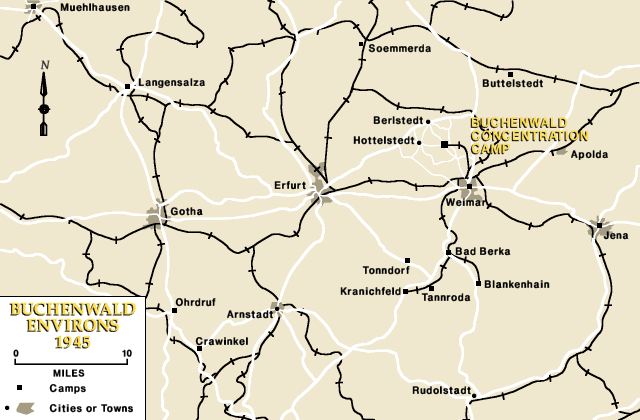 Vintage map of area.
Vintage map of area.Buchenwald Concentration Camp
On May 27th, 1945 British troops took over control of Magdeburg, Germany. This allowed the 30th Infantry Division to move south. The Division command post moved to Possneck near the Czechoslovakian border. The 117th occupied Oelsnitz and Bad Elsren. The 120th moved to an area around Plauen on the 29th of May. The 119th moved around Hirschberg, Germany.
During this time of occupation various units of the 30th division were given educational tours of area historical places. One of those tours was a trip to the Nazi concentration camp of Buchenwald located just north of Weimar, Germany.
On April 11, 1945 the Third U.S. Army reached the Buchenwald Concentration Camp. There were still 21,000 inmates still within the camp after the SS had fled in front of the advancing Allied front. The next day, Edward R. Murrow along with other reporters arrived at the camp. Their horror is reflected in the various reports that came from that encounter. Murrow was not able to get his broadcast on the air until April 15th, and in one of his most eloquent reports he tells listeners the story of his visit to Buchenwald.
Click here to listen to Murrow's actual broadcast...about 10 minutes long.

 30th troops visiting Buchenwald Concentration
Camp, June 1945
30th troops visiting Buchenwald Concentration
Camp, June 1945

On page 254 of the 120th history book reference is made of trips to Buchenwald. In Ed Arn's book "Arn's War" he relates visiting Buchenwald on page 195. The Dr. Heely photo collection on this website contains photos from members of the 113th FA making the trip. (Click here for Heely photos) On page 405 of the 105th Engineer Battalion history mentions it. The 30th Div. Military Police history contains photos of Buchenwald. Also, I have received a group of photos from Byron Bishop who was a Staff Sgt. with the 117th Cannon Company. Mr. Bishop was a forward observer from the inception of the company to after Magdeburg. A special thank your for sharing these with the 30th family.
 Mr. Bishop was not certain of the use of these urns. As he says it
would be hard to believe the Nazi's used them for ashes for the cremated
prisoners. I also found a similar photo in the 30th Military Police
history book but unfortunately the caption was cut off. If you have
information, please let me know.
Mr. Bishop was not certain of the use of these urns. As he says it
would be hard to believe the Nazi's used them for ashes for the cremated
prisoners. I also found a similar photo in the 30th Military Police
history book but unfortunately the caption was cut off. If you have
information, please let me know.
NEW INFORMATION on above photo added 9/27/2009...THANKS MARK!!
. Bishop was not
certain of the use of these urns. As he says it would be hard to believe the
Nazi's used them for ashes for the cremated prisoners. I also found a similar
photo in the 30th Military Police history book but unfortunately the caption was
cut off. If you have information, please let me know.
I was recently deployed to Germany and visited Buchenwald Concentration Camp.
The urns were in fact used for the prisoners' ashes. The remains of prisoners
(who weren't Jewish) who were killed or died at Buchenwald would be cremated.
In turn, the families, for a fee, would get those remains in one of those urns.
I realize this may seem bizarre, but then a lot of the behavior and methodology
of the Nazis is beyond the realm of understanding.
V/r
Mark Olsen
TSGT, NJANG
177FW/PA
 If anyone can help with the translation of any of these signs or writings,
please email.
If anyone can help with the translation of any of these signs or writings,
please email.
 The guide of the camp told Bishop and his men that a Canadian plane got shot
down near the camp. The crew was captured by Buchenwald guards and then hung
from these gallows. Their bodies were left there for months.
The guide of the camp told Bishop and his men that a Canadian plane got shot
down near the camp. The crew was captured by Buchenwald guards and then hung
from these gallows. Their bodies were left there for months.
Mr. Bishop also adds these memories: "The Body Truck was used to take bodies from the entire camp to the crematorium. The cart (rear view) was used in a very methodical process to move the prisoners from the place of the final lethal injections to the ovens. According to our guide, the injections were made at the rear of the 'medical building' and the bodies fell directly into the cart where they went by a track directly to the ovens. The commandant's wife (nicknamed Bitch of Buchenwald) would observe the cart loading process and select bodies that had tattoos she deemed interesting. She held them out so she could make lampshades from their skins. For that reason they were not allowed to see inside the room. After 60 years this still gets to me. It's hard to believe that such people existed."